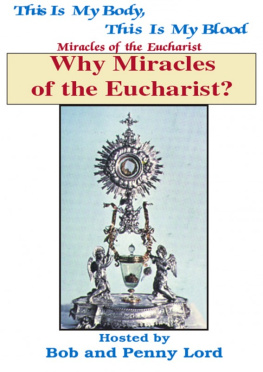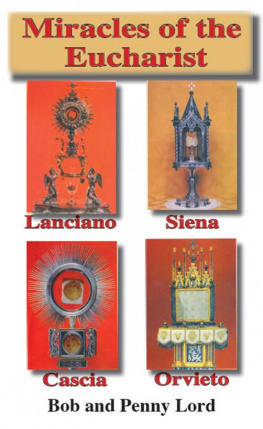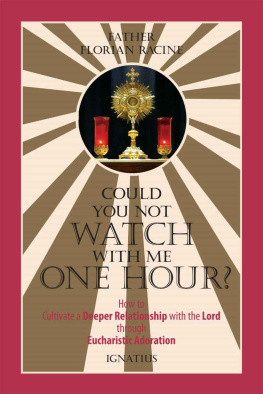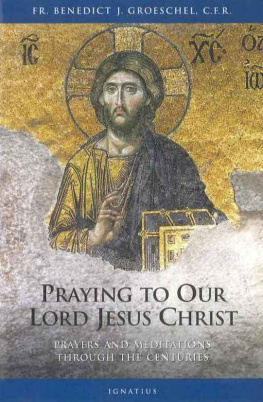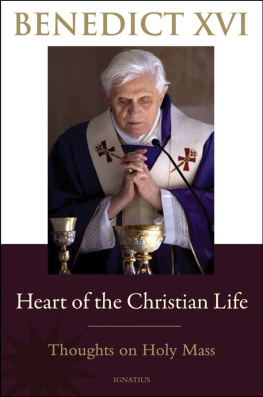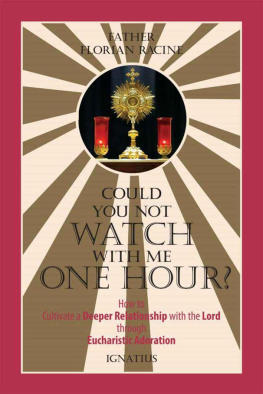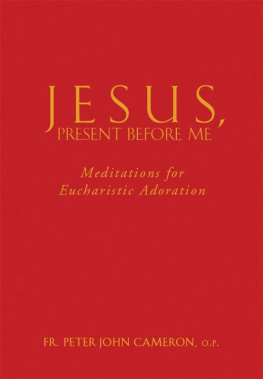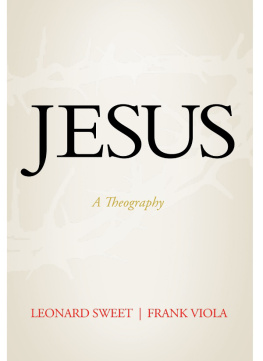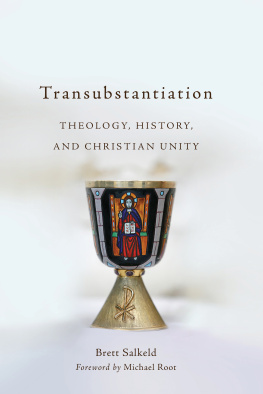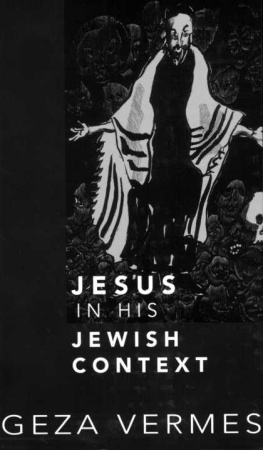Table of Contents
Preamble

JESUS GIVES HIMSELF TO US:
TRANSUBSTANTIATION
CHResources
P.O. Box 8290
Zanesville, OH 43702
740-450-1175
CHResources is a registered trademark of
The Coming Home Network International
Copyright (C) 2010 by CHResources
13 12 11 10 09 1 2 3 4 5
All rights reserved.
Printed in the United States of America
ISBN 978-0-9800066-7-4
Scripture texts cited in this work are taken from the Catholic editionof the Revised Standard Version of the Bible, (C) 1965, 1966 bythe Division of Christian Education of the National Council ofthe Churches of Christ in the United States of America. Used bypermission. All rights reserved.
Layout and design of the print edition by
Jennifer Bitler www.doxologydesign.com
JESUS GIVES HIMSELF TO US: TRANSUBSTANTIATION

One of the post-communion prayers in the Eucharisticliturgy makes this petition: "Lord, by our sharing in themystery of this Eucharist, let your saving love grow withinus. Grant this through Christ our Lord." Notice theitalicized words. We pray and say things like this so oftenin our liturgy we tend to take them for granted. Takeanother and closer look at what Jesus Christ does in thisgreat mystery of the Eucharist.
START WITH THE INCARNATION

Ponder these astounding words from the prologue tothe Fourth Gospel: "In the beginning was the Word, andthe Word was with God, and the Word was God.... Andthe Word became flesh and dwelt among us, full of graceand truth" (John 1:1, 14a). Sacred Scripture is tellingus that Almighty God has become part of the materialworld. And all for the purpose of working out oursalvation through the human nature (body as well as soul)of his divine Son.
Now that Christ has been raised in glory, throughhis transfigured human nature God mediates to us thesalvation Christ has won for us. God acts on us in anintimate, person-to-person way. Our contact with God isa spiritual reality made possible by God's grace and by ourresponse to that grace in faith. And so for all persons whohave faith in Christ, he makes himself spiritually availableto them. But in his infinite love for us, Jesus Christ haschosen to do far more than be simply spiritually available.
DIRECT CONTACT WITH HIS HUMAN NATURE
IN THE EUCHARIST, JESUS CHRISTGIVES US DIRECT CONTACT WITHHIS HUMAN NATURE

Think of your senses: hearing, seeing, touching,tasting. You can hear or see something, but your sense ofhearing or seeing is detached from its object. You are notin direct physical contact with what you hear or see.
Touching is different. You come into direct contactwith something by putting your fingers or your handon that object. Tasting is a form of touching, but with avery great difference. Tasting -- eating -- actually bringsabout a union between yourself and the objects of yourtasting (eating). What you eat literally becomes part ofyou.
Now this is deeply significant: the central act of theCatholic religion is an act of feeding on particular food.Jesus wants us to be united with him through faith, ofcourse. But through his Church he has provided formuch more intimate contact with himself. He has givenus food -- the Eucharist -- through which he gives us hisvery self. At the Last Supper he said of the elements, "Thisis my body.... this is my blood" (Matt. 26:26, 28).
Jesus Christ gives us himself under forms of breadand wine. In all the other sacraments, Jesus uses physicalmeans through which he gives us his grace: the water ofbaptism, the oil of anointing, and so forth. But in theEucharist, the physical means Jesus uses become JesusChrist himself.
Only God himself could fully explain the miracleof the Eucharist, but the Holy Spirit enables hisChurch to describe the miracle, in her doctrine oftransubstantiation.
TRANSUBSTANTIATION

To describe what happens in the Eucharistic action,the Church uses two basic concepts. The first is"substance": the inner essence of something, what it reallyis at the core of its being. The second is "accidents" (orwe might use another word, "appearances"): the qualitiesof a thing that we can experience by one or more of oursenses.
As an example of "accidents," take a book. Youcan see its shape, its weight, its color. You might evenimitate a toddler and tear out a page and chew on it totest its flavor. What you can see or feel or taste are the"accidents," the "appearances," of the book. But theessence of this object is something else -- the book itself.
In the Eucharist, the appearances of the bread andwine remain unchanged. The essence of the breadand wine is totally changed. Their essence is changedinto the very Body and Blood, Soul and Divinity, ofthe Lord Jesus Christ. The Church calls this change"transubstantiation." The change is both miraculous andunique.
We human beings can change both the inner essence("the substance") of something and its appearances ("theaccidents"). By cooking, we can change wheat into bread.In its essence it is no longer wheat, and the appearances("the accidents") are also changed.
We human beings can change the appearances ofsomething without changing the substance. We can freezewater so that it no longer looks like water, but it's stillwater. We can transform water into steam so that it nolonger looks like water, but it's still water.
But here is something impossible for us: We can neverchange the inner essence ("the substance") of somethingwithout changing its appearances ("the accidents"). OnlyGod can do that. That's exactly what he does in theconsecration of the Eucharist. God changes the substanceof the bread and wine into the Body and Blood, Souland Divinity of Jesus Christ. But the accidents, theappearances of bread and wine, remain unchanged.
Here is the miracle, enacted by God at every Catholicaltar. The Blessed Sacrament does not merely give us aspiritual presence of our Lord. This Sacrament gives usthe actual flesh and blood of the risen Christ to be ourfood, to become literally part of us.
TWO ARTICLES OF FAITH REGARDING OUR LORD'S EUCHARISTIC PRESENCE

The Church teaches that the bodily presence of therisen and ascended Christ is in heaven, where "he isseated at the right hand of the Father." Over 1500 yearsago Pope Leo the Great proclaimed, "The Son of Godentered into the lowliness of this world, descending fromHis heavenly throne yet not leaving the glory of the Father."While the Eternal Word was on earth in his humanity-- being born of a virgin, teaching, preaching, healing,suffering and dying on the Cross -- the Eternal Word inhis divinity was at the same time governing the universewith the other Persons of the Blessed Trinity.


